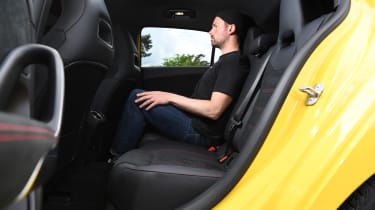Mercedes A-Class review - Practicality, comfort and boot space
Boot and cubby spaces are an improvement over the old car’s, but the A-Class is still not as roomy as an Audi A3

The A-Class is available as a five-door hatch and four-door saloon. Up front, the driving position is great – there’s plenty of adjustment for both the seat and the steering wheel, so it’s easy to get comfy. Mercedes has made an effort to slim down the plastic trim around the pillars, and as a result visibility, particularly over the shoulder, has improved. However, it can feel a little claustrophobic in the back compared to some of the A-Class’ rivals because of the front seats – their shape and size block out a lot of the light.
In terms of cubby spaces, the A-Class is pretty standard for the class. There’s a big central storage bin, a couple of cup holders ahead of the infotainment touch pad, and a smartphone-sized space at the base of the dash. The front door pockets are roomy enough for a large bottle, but those in the back are small.
It's worth noting that while refinement is good on most models, the A 35's large 19-inch wheels roar on the move – a trait that's pretty tiring on longer journeys. The car's sporty bias also means it feels a bit fidgety on the move, detracting from long-distance comfort.
Size
The A-Class hatchback measures 4,428mm long, 1,796mm wide and 1,423mm tall. That’s 136mm longer than the old car, and larger than the A3 Sportback in every dimension – the extra 91mm in length could make a difference when parking in tight spaces. The 2,729mm wheelbase is also longer than the A3’s 2,640mm space between its axles.
Used - available now

2023 Mercedes
A Class
53,396 milesAutomaticPetrol1.3L
Cash £16,600
2021 Mercedes
A Class
8,789 milesAutomaticPetrol1.3L
Cash £23,000
2021 Mercedes
A Class
43,718 milesAutomaticPetrol1.3L
Cash £16,387
2022 Mercedes
A Class
53,149 milesAutomaticPetrol1.3L
Cash £15,000The A-Class saloon is longer at 4,558mm, but is the same width and just 6mm taller.
Leg room, head room & passenger space
Mercedes states that there’s more elbow and headroom in the back compared to the previous A-Class. However, a lack of knee room means that when filled with four six footers, it’s more cramped than the Audi. Headroom is fine, unless you’re in the raised middle seat. That central berth is narrow too, so it’s not a comfortable place to sit.
On the plus side, it’s really easy to fit a child seat. The ISOFIX mounts are clearly exposed by plastic openings, and the doors open fairly wide.
When we pitted the Mercedes A-Class head-to-head against the DS 4 E-Tense in a twin test, we found that the A-Class offers more headroom and its cabin is wider too. That said, the DS 4 is more generous when it comes to knee room.
|
Rear seat space comparison | |||
|
Knee room (min-max) |
Headroom |
Elbow room | |
|
Mercedes A-Class |
563-817mm |
920mm |
1,425mm |
|
DS 4 |
575-836mm |
914mm |
1,390mm |
Boot
One criticism of the previous model is that the boot wasn’t just smaller than most rivals, but hard to make use of due to a narrow opening. The new car addresses both of these issues to an extent – the opening is a useful 20cm wider, and the total volume is up to 355 litres. That’s a nominal 25 litres fewer than front-wheel drive A3 models, but more than quattro-equipped cars. There’s also a tiny bit of underfloor storage for hiding away smaller items.
The rear seat backs fold in a 40/20/40 split, but the boot floor isn’t quite flat. With the seats down and the car loaded to the roof, capacity increases to 1,195 litres – still 5 litres less than the Audi. The A 250 e saloon meanwhile can pack between 345 to 1,125 litres with the seats raised and lowered respectively, while the conventional combustion models, without a battery occupying some of their luggage space, extend that to 405 litres seats-up and 1,200-1,210 litres with the seats folded.
We also measured the boot space of the A-Class ourselves when we pitted it against the DS 4 E-Tense in our twin test. We found that while the DS 4’s boot is wider than the A-Class’s, the Mercedes gained points back by having a longer boot and lower load height too, which make it easier to load heavier items in.
|
Boot space comparison | |||
|
Length |
Width |
Lip height | |
|
Mercedes A-Class |
817mm |
1,038mm |
642mm |
|
DS 4 |
782mm |
1,098mm |
729mm |
Towing
The A 180 petrol is rated to tow 1,400kg, while the A 200, A 200 d and A 250 e have a maximum towing capacity of 1,600kg, and AMG models 1,800kg.










